Mission
| | This section is empty. You can help by adding to it. (June 2021) |
| Air Warning Squadron 9 | |
|---|---|
| Active | 1 Apr 1944 – 9 Dec 1945 |
| Country | United States |
| Allegiance | United States of America |
| Branch | United States Marine Corps |
| Type | Aviation Command & Control |
| Role | Aerial surveillance & early warning |
| Size | 343 |
| Commanders | |
| Current commander | N/A |
Air Warning Squadron 9 (AWS-9) was a United States Marine Corps aviation command and control squadron during World War II. The squadron's primary mission was to provide aerial surveillance and early warning of approaching enemy aircraft during amphibious assaults. Formed in April 1944, the squadron did not deploy overseas until after the end of the war. It arrived in Tokyo Bay to take part in the occupation of Japan only to find out it was not required. The squadron returned to the U.S. and was decommissioned shortly after in December 1945. To date, no other Marine Corps squadron has carried the lineage and honors of AWS-9 to include the former Marine Air Control Squadron 9 (MACS-9).
| | This section is empty. You can help by adding to it. (June 2021) |
Air Warning Squadron 9 was commissioned on 1 April 1944, as part of Marine Air Warning Group 1 at Marine Corps Air Station Cherry Point, North Carolina. [2] On 21 April the squadron moved to Marine Corps Outlying Field Oak Grove in Pollocksville, North Carolina. Air Warning Group 1 maintained its training equipment at the Pollocksville site and each new Air Warning Squadron commissioned rotated through for their first familiarization on the gear. While there the squadron conducted more than 250 day interception and 84 night interceptions while working with VMF-511, VMF-512, VMF-513, VMF-514, VMF-314 and VMF-324. On 27 May 1944, the squadron returned to MCAS Cherry Point in preparation for transfer to the west coast. [3]
AWS-9 departed North Carolina via rail on 5 June 1944, arriving at Marine Corps Air Depot Miramar, California on 10 June. [4] At Miramar, AWS-9 fell under the command of Air Warning Group 2. In early June the squadron began drawing training equipment from AWG-2 in preparation for additional training throughout Southern California. Besides MCAD Miramar, the squadron also sent training detachments to Camp Callan near La Jolla and Marine Corps Base Camp Pendleton. On 10 November 1944, the squadron's duties were changed to that of a replacement training squadron for air warning personnel. The squadron was relocated to Marine Corps Auxiliary Airfield Gillespie just south east of MCAD Miramar in January 1945.
On 1 February 1945, the squadron was reverted to being a combat squadron and began preparing for deployment to the Pacific Theater. [5] The squadron sent detachments to Ream Field in Imperial Beach and Camp Callan. In April the squadron began training on new radar equipment fielded to include the SK-1M, SP-1M, and AN/TPS-1B. [6] On 15 May the squadron received a warning order to be prepared to deploy overseas. 2 officers and 29 enlisted marines departed San Diego 28 May on board the USS Algol (AKA-54) and the remaining 27 officers and 285 enlisted men departed on 30 May on board the USS Cleburne (APA-73). [7]
AWS-9 Marine disembarked at Pearl Harbor between 4-6 Jun and moved to Marine Corps Air Station Ewa where it fell under the command of the 3rd Marine Aircraft Wing. While at MCAS Ewa the squadron went to the field for additional training on nighttime GCI. On 23 August, the squadron received a warning order which cancelled all training and order preparation for immediate embarkation on amphibious shipping. Squadron departed Pearl Harbor on 13 September onboard LST 487 & LST-564. The LSTs arrived at the fleet anchorage at Eniwetok Atoll on 23 September and remained there until 7 October. [8] On 18 October AWS-9 arrived in Tokyo Bay off Yokosuka Naval Base. Marine Aircraft Group 31 (MAG-31) informed squadron leadership at that time that its services were not required for occupation duty. [9]
AWS-9 was decommissioned on 8 December 1945.
A unit citation or commendation is an award bestowed upon an organization for the action cited. Members of the unit who participated in said actions are allowed to wear on their uniforms the awarded unit citation. What follows is an incomplete list of the awards AWS-9 has been presented with:
| Streamer | Award | Year(s) | Additional Info |
|---|---|---|---|
| | World War II Victory Streamer | 1943–1945 | World War II |

Marine Fighter Attack Training Squadron 502 (VMFAT-502) is a United States Marine Corps fighter attack training squadron flying the Lockheed Martin F-35 Lightning II. Known as the "Flying Nightmares", the squadron maintains the history of Marine Attack Squadron 513 (VMA-513) which dates back to World War II and was decommissioned on 12 July 2013. The squadron is based at Marine Corps Air Station Miramar and falls under the command of Marine Aircraft Group 11 and the 3rd Marine Aircraft Wing
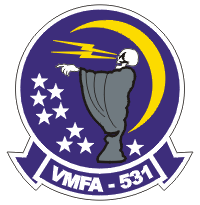
Marine Fighter Attack Squadron 531 (VMFA-531) was a United States Marine Corps fighter squadron consisting of various types aircraft from its inception culminating with the F/A-18 Hornet. Known as the "Grey Ghosts", the squadron participated in action during World War II and the Vietnam War. They were decommissioned on 27 March 1992.

Marine Air Control Squadron 1 (MACS-1) is a United States Marine Corps aviation command and control squadron. The squadron provides aerial surveillance, air traffic control, ground-controlled intercept, and aviation data-link connectivity for the I Marine Expeditionary Force. It was the first air warning squadron commissioned as part of the Marine Corps' new air warning program and is the second oldest aviation command and control unit in the Marine Corps. The squadron is based at Marine Corps Air Station Yuma and falls under Marine Air Control Group 38 and the 3rd Marine Aircraft Wing.

Marine Air Control Squadron 2 (MACS-2) is a United States Marine Corps aviation command and control squadron. The squadron provides aerial surveillance, Ground-controlled interception, and air traffic control for the II Marine Expeditionary Force. They are based at Marine Corps Air Station Cherry Point and fall under Marine Air Control Group 28 and the 2nd Marine Aircraft Wing.
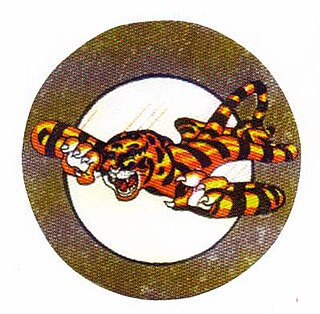
Marine Fighter Squadron 911 (VMF-911) was an aircraft squadron of the United States Marine Corps during World War II. Known as the "Devilcats", it served as a training squadron during the war, and was decommissioned in early 1946.

Marine Air Control Squadron 7 (MACS-7) was a United States Marine Corps aviation command and control squadron. The squadron provided aerial surveillance and ground-controlled interception and saw action most notably during the Battle of Okinawa in World War II and the Vietnam War. They were last based at Marine Corps Air Station Yuma and fell under the command of Marine Air Control Group 38 (MACG-38) and the 3rd Marine Aircraft Wing.
Air Warning Squadron 2 (AWS-2) was a United States Marine Corps aviation command and control squadron during World War II. The squadron was tasked to provide aerial surveillance and early warning during amphibious assaults. They took part in the Battle of Guam in 1944 and would eventually move to Peleliu in 1945 assuming responsibility for air defense in that sector until the end of the war. The squadron departed Peleliu for the United States in January 1946 and was quickly decommissioned upon its arrival in California. To date, no other Marine Corps squadron has carried the lineage and honors of AWS-2 to include Marine Air Control Squadron 2 (MACS-2).
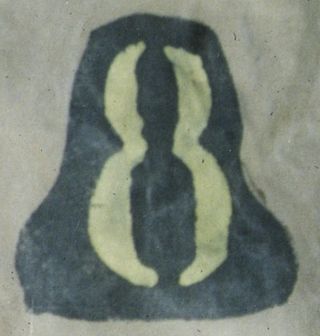
Air Warning Squadron 8 (AWS-8) was a United States Marine Corps aviation command and control unit that provided aerial surveillance and early warning of enemy aircraft during World War II. The squadron was commissioned on 3 March 1944 and was one of five Marine Air Warning Squadrons that provided land based radar coverage during the Battle of Okinawa in 1945. AWS-8, utilizing the callsign "Arsenic," remained on Okinawa as part of the garrison force following the Surrender of Japan. The squadron departed Okinawa for the United States in February 1946 and was quickly decommissioned upon its arrival in California. To date, no other Marine Corps squadron has carried the lineage and honors of AWS-8 to include Marine Air Control Squadron 8 (MACS-8).
Air Warning Squadron 6 (AWS-6) was a United States Marine Corps aviation command and control unit that provided aerial surveillance and early warning of enemy aircraft during World War II. The squadron was activated on 1 January 1944 and was one of five Marine Air Warning Squadrons that provided land based radar coverage during the Battle of Okinawa in 1945. AWS-6 remained on Okinawa as part of the garrison force following the Surrender of Japan. The squadron departed Okinawa for the United States in February 1946 and was quickly decommissioned upon its arrival in California. To date, no other Marine Corps squadron has carried the lineage and honors of AWS-6 to include Marine Air Control Squadron 6 (MACS-6).

Marine Air Control Squadron 3 (MACS-3) was a former United States Marine Corps aviation command and control squadron. During its later years it also served as an operational test and evaluation squadron. Originally formed in World War II as Air Warning Squadron 12 (AWS-12), its original mission was to provide aerial surveillance and ground-controlled interception (GCI) for Marine Corps forces during amphibious operations. The squadron did not participate in combat operations during WWII however it did deploy and operate during the Korean War. In 1961, MACS-3 was transferred from the Fleet Marine Force to the administrative control of Air, Fleet Marine Forces Pacific in order to serve as the operational test and evaluation squadron for what was at the time, the largest research and development project in the Marine Corps - Marine Tactical Data System (MTDS). After MTDS testing was complete the Marine Corps recognized that it was not properly staffed to develop, test, and acquire new digital equipment. On 1 July 1970, MACS-3 was decommissioned and its structure and equipment were utilized to form Marine Corps Tactical Systems Support Activity (MCTSSA) at Marine Corps Base Camp Pendleton, California. Of note, MCTSSA does not carry MACS-3's lineage and honors.

Robert O. Bisson was a brigadier general in the United States Marine Corps who served in both World War II and the Korean War. A naval aviator and communications engineer, he was at the forefront of the Marine Corps' use of radar for early warning and fighter direction. In 1943, as a member of VMF(N)-531, he supervised the installation and operation of the Marine Corps' first ground-controlled interception (GCI) equipment utilized in a combat zone. During the Battle of Okinawa he commanded the headquarters responsible for coordinating the Marine Corps' ground-based air defense units.
Air Warning Squadron 3 (AWS-3) was a United States Marine Corps aviation command and control squadron during World War II. The squadron's primary mission was to provide aerial surveillance and early warning of approaching enemy aircraft during amphibious assaults. The squadron participated in the Philippines campaign (1944–1945) in support of the Eighth Army on Mindanao. AWS-3 was decommissioned shortly after the war in October 1945 at Marine Corps Air Station Miramar, California. To date, no other Marine Corps squadron has carried the lineage and honors of AWS-3 to include the former Marine Air Control Squadron 3 (MACS-3).
Assault Air Warning Squadrons were United States Marine Corps aviation command and control units formed during World War II to provide early warning, aerial surveillance, and ground controlled interception during the early phases of amphibious landing. These squadrons were supposed to be fielded lightweight radars and control center gear in order to operate for a limited duration at the beginning of any operation until larger air warning squadrons came ashore. Four of these squadrons were commissioned during the war with one, AWS(AT)-5, taking part in the Battle of Saipan. All four squadrons were decommissioned on 10 November 1944 because the Marine Corps was unable to field the required mobile radars. The "first in" capability that the Assault Air Warning Squadrons were supposed to provide was transferred to the Early Warning Teams that were added to the tables of organization for the regular air warning squadrons.
Air Warning Squadron 4 (AWS-4) was a United States Marine Corps aviation command and control squadron during World War II. The squadron's primary mission was to provide aerial surveillance and early warning of approaching enemy aircraft during amphibious assaults. The squadron participated in the Philippines campaign (1944–1945) in support of the Eighth Army on Mindanao. AWS-4 was decommissioned shortly after the war in October 1945. To date, no other Marine Corps squadron has carried the lineage and honors of AWS-4 to include Marine Air Control Squadron 4 (MACS-4).
Air Warning Squadron 14 (AWS-14) was a United States Marine Corps aviation command and control squadron during World War II. The squadron's primary mission was to provide aerial surveillance and early warning of approaching enemy aircraft during amphibious assaults. Formed in June 1944, the squadron was one of a handful of air warning squadrons that was never able to deploy overseas during the war. The squadron was decommissioned shortly after the end of the war in November 1945. To date, no other Marine Corps squadron has carried the lineage and honors of AWS-14 to include the former reserve Marine Air Control Squadron 14 (MACS-14).

The VMF(N)-531 GCI Detachment was a short-lived aviation command and control unit that was part of the United States Marine Corps's first night fighter squadron, VMF(N)-531. This detachment was the Marine Corps' first dedicated GCI detachment utilized in a combat zone. In the early phases of World War II the Marine Corps did not have stand-alone early warning and ground-controlled intercept (GCI) units so these capabilities were initially placed in the headquarters of each Marine Aircraft Group and with individual night fighter squadrons. The detachment was deployed in the South Pacific from August 1943 through August 1944 and was responsible for the interception of numerous Japanese aircraft. Lessons learned from this deployment were instrumental in establishing tactics and procedures for the Marine Corps' newly established Air Warning Program. Upon returning from its first and only deployment, the detachment was dissolved and its members went on to serve as instructors at the 1st Marine Air Warning Group, which was responsible for training new squadrons. Many of them later served in leadership roles in these Air Warning Squadrons as they supported follow on combat operations.
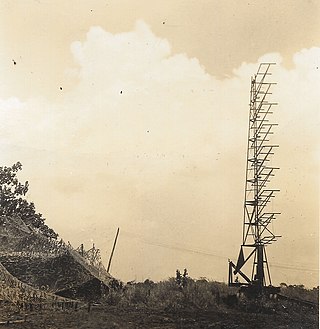
The Marine Corps Early Warning Detachment, Guadalcanal (1942–43) was a ground based early-warning radar detachment that provided long range detection and rudimentary fighter direction against Japanese air raids during the Battle of Guadalcanal. Initially deployed as part of the headquarters of Marine Aircraft Group 23, this detachment established an SCR-270 long range radar that allowed the Cactus Air Force to husband its critically short fighter assets during the early stages of the battle when control of the island was still very much in doubt. The detachment arrived on Guadalcanal on 28 August 1942, began operating in mid-September, and did not depart until early March 1943. Combat lessons learned from this detachment had a great deal of influence on the Marine Corps' development of its own organic, large scale air warning program which began in early 1943.

Marine Night Fighter Squadron 532 was a United States Marine Corps night fighter squadron that was commissioned during World War II. The squadron, which flew the F4U-2 Corsair, was the second night fighter squadron commissioned by the Marine Corps, the first to fly a single-seat, radar-equipped night fighter, and the only Marine squadron to fly the F4U-2 in combat. VMF(N)-532 saw extensive combat operations throughout 1944 in support of Marine Corps operations at Kwajalein Atoll and the Mariana Islands. The squadron was decommissioned on 31 May 1947, as part of the post-war draw down of the service. Since then, no other Marine Corps squadron has carried the lineage and honors of VMF(N)-532.
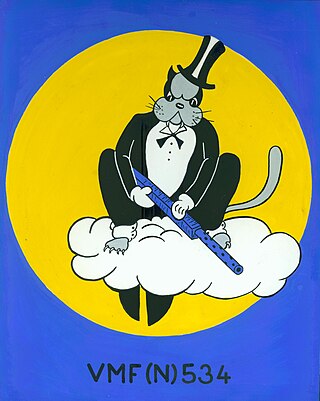
Marine Night Fighter Squadron 534 was a United States Marine Corps night fighter squadron that was commissioned during World War II. It was the fourth night fighter squadron commissioned in the service and participated in limited combat operations throughout 1944 and 1945 during Marine Corps operations over Kwajalein Atoll and the Mariana Islands. The squadron was decommissioned on 31 May 1947, as part of the post-war draw down of the service. Since then, no other Marine Corps squadron has carried the lineage and honors of VMF(N)-534.